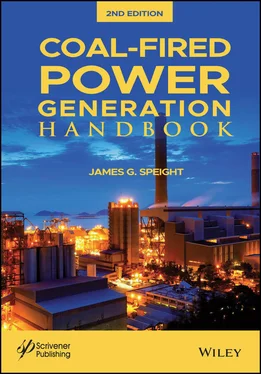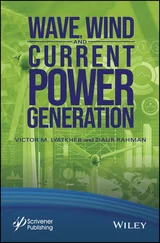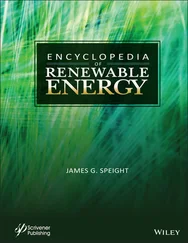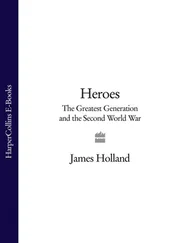ASTM. 2011. Annual Book of ASTM Standards . American Society for Testing and Materials, West Conshohocken, Pennsylvania.
ASTM D388. Classification of Coals by Rank. Annual Book of ASTM Standards . Section 05.05. American Society for Testing & and Materials, West Conshohocken, Pennsylvania.
Berkowitz, N., and Schein, H.G. 1951. Heats of Wetting and the Spontaneous Ignition of Coal. Fuel , 30: 94-96.
Berkowitz, N., and Speight, J.G. 1973. Prevention of Spontaneous Heating of Coal. Can. Inst. Min. Metall. Bull ., 66(736): 109.
Carpenter, A.M. 1988. Coal Classification . Report No. IEACR/12. International Energy Agency, London, United Kingdom.
Chakravorty, R.N. 1984. Report No. ERP/CRL 84-14. Coal Research Laboratories. Canada Centre for Mineral and Energy Technology, Ottawa, Ontario, Canada.
Chakravorty, R.N., and Kar, K. 1986. Report No. ERP/CRL 86-151. Coal Research Laboratories. Canada Centre for Mineral and Energy Technology, Ottawa, Ontario, Canada.
DOE/EIA. 1995. Coal Data: A Reference . Report No. DOE/EIA-0064(93). Energy Information Administration, United States Department of Energy, Washington, DC.
Fessenden, R.J., and Fessenden, J.S. 1990. Organic Chemistry . Brooks/Cole Publishing Company, Pacific Grove, California.
Francis, W. 1961. Coal: Its Formation and Composition . Edward Arnold Ltd., London.
Frazer, P. Jr. 1877. Classification of Coal. Trans. Am. Inst. Min. Eng . 6: 430-451.
ISO 2950. Brown Coal and Lignites - Classification by Types on the Basis of Total Moisture Content and Tar Yield. International Standards Organization, Geneva, Switzerland.
Kreulen, D.J.W. 1948. Elements of Coal Chemistry . Nijgh and van Ditmar N.V., Rotterdam, The Netherlands.
Luppens, J.A., and Hoeft, A.P. 1992. Journal of Coal Quality . Spackman, W. 1958. Trans. New York Acad. Sci. Series 2. 20(5):
Parr, S.W. 1922. The Classification of Coal. Ind. Eng. Chem., 14(10): 919-922.
Ramawat, K.G. and Merillon, J-M. 2013. Handbook of Natural Products: Phytochemsitry, Botany, Metabolism . Springer Science, New York.
Speight, J.G. 2014. The Chemistry and Technology of Petroleum . 5th Edition. CRC Press, Taylor & Francis Group, Boca Raton, Florida.
Speight, J.G. 2011. The Biofuels Handbook . Royal Society of Chemistry, London, United Kingdom.
Speight, J.G. 2013. The Chemistry and Technology of Coal . 3rd Edition. CRC Press, Taylor & Francis Group, Boca Raton, Florida.
Speight, J.G. 2014. The Chemistry and Technology of Petroleum . 5th Edition. CRC Press, Taylor & Francis Group, Boca Raton, Florida.
Speight, J.G. 2015. Handbook of Coal Analysis . 2nd Edition. John Wiley & Sons Inc., Hoboken, New Jersey.
Speight, J.G. 2020. Synthetic Fuels Handbook: Properties, Processes, and Performance . 2nd Edition. McGraw-Hill, New York.
Stach, E., Taylor, G.H., Mackowsky, M-Th., Chandra, D., Teichmuller, M. and Teichmuller, R. 1982. Textbook of Coal Petrology . 3rd Edition. Gebruder Bornfraeger, Stuttgart, Germany.
Stopes, M. 1919. Proc. Roy. Soc . 90B: 470.
Stopes, M. 1935. Fuel . 14: 6.
Thiessen, R. 1931. Bulletin No. B344. United States Bureau of Mines, Washington, DC.
Uribe, C.A., and Pérez, F.H. 1985. Proposal for Coal Classification. Fuel, 64: 147-150.
Van Krevelen, D.W., and Schuyer, J. 1957. Coal Science: Aspects of Coal Constitution . Elsevier, Amsterdam.
White, D. 1911. Bulletin No. B29. United States Bureau of Mines, Washington, D.C.
3
Recovery, Preparation, and Transportation
3.1 Introduction
Coal is composed of complex mixtures of organic and inorganic compounds ( Chapter 1) and must be handled in the correct manner to prevent accidents and spontaneous ignition as well as spontaneous combustion ( Chapters 1, 4, 5) (Speight, 2013; CFR, 2012; Speight, 2020).
The organic compounds, inherited from the plants that live and die in the swamps cannot be counted with even a minute degree of accuracy. On the other hand, the more than 100 inorganic compounds in coal either were introduced into the swamp from water-borne or wind-borne sediment or were derived from elements in the original vegetation; for instance, inorganic compounds containing such elements as iron and zinc are needed by plants for healthy growth. After the plants decompose the inorganic compounds remain in the resulting peat. Some of those elements combine to form discrete minerals, such as pyrite (FeS 2). Other sources of inorganic compounds used by the plants may be the mud that coats the bottom of the mire, sediments introduced by drainage runoff, dissolved elements in the mire water, and wind-borne sand, dust, or ash.
Coal may contain elements in only trace amounts (on the order of parts per million). Occasionally, some trace elements may be concentrated in a specific coal bed, which may make that bed a valuable resource for those elements (such as silver, zinc, or germanium). Some elements, however, have the potential to be hazardous (for example, cadmium or selenium), particularly if they are concentrated in more than trace amounts. Although as many as 120 different minerals have been identified in coal, only approximately 33 of these minerals commonly are found in coal, and, of these, only approximately eight minerals are sufficiently abundant to be considered major constituents.
When coal is combusted, as in a coal-fired power plant to generate electricity, most of the mineral matter and trace elements generally form ash. However, some minerals break down into gaseous compounds, which go out through the furnace flue. Pyrite, for example, breaks down into the individual elements iron and sulfur and each element combines with oxygen to become, respectively, iron oxide and an oxide of sulfur – the sulfur oxides are emitted in the flue gases while the iron oxide become part of ash.
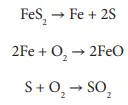
In some highly oxidative conditions, ferric oxide (Fe 2O 3) may be formed.
Some trace elements also dissociate from their organic or mineral hosts when coal is burned – most become part of the ash, but a few of the more volatile elements, such as mercury and selenium, may be emitted in the flue gas.
The term coal quality is used to distinguish the range of different commercial steam coals that are produced directly by mining or are produced by coal cleaning (Speight, 2013). The factors considered in judging the quality of a coal are based on, but not limited to, (i) heat value, (ii) moisture content, (iii) mineral matter content, reflect as mineral ash after combustion, (iv) fixed carbon, (v) sulfur content, (vi) the content of major, minor, and trace elements, (vii) the coking properties, (viii) the petrologic properties, and (ix) the organic constituents considered both individually and in groups. The individual importance of these factors varies according to the intended use of the coal. These properties are determined in the United States according to standards established by the standard test methods developed and published by the ASTM International (formerly the American Society for Testing and Materials, ASTM) and are usually denominated in English units (e.g., Btu/lb for heating value on a mass basis) (ASTM, 2020).
As a side note at this point, in addition to the difference in heating value (i.e., Btu/lb), electricity generating units fueled with subbituminous and lignite coals tend to operate at lower efficiency (higher heat rate) than units fueled with bituminous coal. This can lead to differences in generating capacity when using different coals.
Читать дальше
